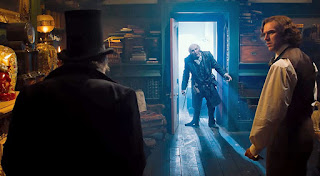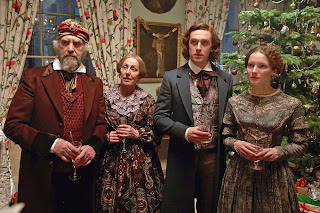Do not expect spectacular visual effects like materializing ghosts in The Man Who Invented Christmas. For that matter, forget about being transported via time machine to the past and future. But it is also true this is a movie involving Ebenezer Scrooge and Ghosts of Christmas Past, Present and Future. Based on Les Stanford’s historical fiction book of the same name, this film adaptation is closer to being a stage production than a digital effects-driven fantasy.
As such, The Man Who Invented Christmas is a handsomely filmed and solidly acted 104 minutes. Compelling? Well, so-so. A unique take on the familiar Charles Dickens tale, A Christmas Carol? Definitely.
Be forewarned: If you have neither read the book nor seen one of the 200-plus film and stage productions, forget about seeing this one. You just won’t get it.
 The Man Who Invented Christmas is aptly named since the film’s plot involves the six desperate weeks Charles Dickens had in 1843 to create what would be finally titled A Christmas Carol. It became his best remembered work, and a holiday season must-read and must-see. During radio’s golden heyday in the 1930’s and ‘40s, it also became a must-hear.
The Man Who Invented Christmas is aptly named since the film’s plot involves the six desperate weeks Charles Dickens had in 1843 to create what would be finally titled A Christmas Carol. It became his best remembered work, and a holiday season must-read and must-see. During radio’s golden heyday in the 1930’s and ‘40s, it also became a must-hear. Through screenwriter Susan Coyne and director Bharat Nalluri, we first see Charles Dickens (well played by Dan Stevens) during one of his touring lectures, playing to an audience packed with those who want to see and hear the author of the best selling novel, Oliver Twist. At this point, Dickens and his manager are in turmoil. Since Oliver Twist, Dickens had authored three books—all rejected by publishers. His professional fate now rests on creating a new novel, and the deadline grows near.
 At this point in the film, Dickens’ creativity mixes with his personal life at home in London. He is surrounded by a doting (and pregnant) wife, several children, servants, and his live-in parents. His relationship with his deadbeat father John (Jonathan Pryce) is strained. And there are bills to be paid.
At this point in the film, Dickens’ creativity mixes with his personal life at home in London. He is surrounded by a doting (and pregnant) wife, several children, servants, and his live-in parents. His relationship with his deadbeat father John (Jonathan Pryce) is strained. And there are bills to be paid. There is sage advice I was once given when writing fiction: “Write about that which you know.” Dickens fully recognizes such, and begins creating characters to drive a plot around a central Christmas theme. “Get the name right,” he says, “and if you’re lucky, a character will appear.”
The characters’ names and personages are therefore based upon those who he knows…from relatives to strangers. His thoughts are then visualized for us. For example, one gent he briefly meets becomes Scrooge (finely portrayed by Christopher Plummer). Eventually, all the characters come to Dickens’ mind, and adapted into his new book. They even hang around his study, invisible to others since they are solely in his—as they say—mind’s eye.
The Man Who Invented Christmas is a well crafted film with gorgeous period settings and costumes. I guess there is nothing really wrong about it resembling a high budget Hallmark Channel movie.
——————————
GRADE on an A-F Scale: B-



